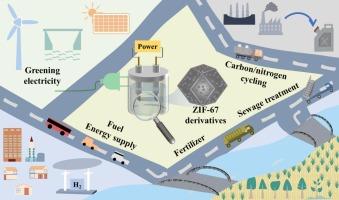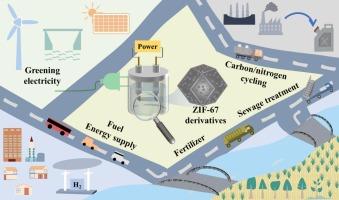电催化中的 ZIF-67 衍生物
IF 20.3
1区 化学
Q1 CHEMISTRY, INORGANIC & NUCLEAR
引用次数: 0
摘要
通过退火、电化学重构和离子交换等工艺获得的 ZIF-67 衍生材料有效地克服了 ZIF-67 固有的低导电性和稳定性的限制,同时保留了其多孔结构和高比表面积。这些衍生物不仅能解决这些问题,还能灵活调节成分结构,使其成为电催化应用的理想候选材料。本综述深入探讨了 ZIF-67 衍生物在传统电催化中的新应用,填补了现有文献中的一个重要空白。综述首先阐明了催化剂改性的常见策略,为理解后续章节奠定了基础。然后详细概述了用于合成 ZIF-67 衍生物的方法,随后全面考察了这些衍生物在电催化中的应用。这一探讨涵盖了一系列应用,包括水分离、二氧化碳还原、燃料电池和金属空气电池。此外,综述还分析了 MOF 衍生物的修饰和合成如何影响这些材料的微观结构和催化性能。最后,综述对将 MOF 衍生物整合到电催化系统中所遇到的挑战进行了批判性评估,并对未来潜在的研究方向提出了见解。通过对这些方面的探讨,本研究旨在启发和指导研究人员克服现有障碍,从而释放 MOF 衍生物在电催化领域的全部潜力。本文章由计算机程序翻译,如有差异,请以英文原文为准。


ZIF-67 derivatives in electrocatalysis
ZIF-67-derived materials, obtained by processes such as annealing, electrochemical reconstruction, and ion exchange, effectively overcome the limitations of low conductivity and stability that are inherent in ZIF-67, all while preserving their porous structure and high specific surface area. These derivatives not only address these issues but also offer the flexibility to modulate the component structure, rendering them promising candidates for electrocatalytic applications. This review delves into the novel application of ZIF-67 derivatives in conventional electrocatalysis, filling a crucial gap in the existing literature. The review begins by elucidating common strategies for catalyst modification, providing a foundation for understanding the subsequent sections. It then offers a detailed overview of the methods used to synthesize ZIF-67 derivatives, followed by a comprehensive examination of their application in electrocatalysis. This exploration covers a range of applications, including water splitting, CO2 reduction, fuel cells, and metal-air batteries. Furthermore, the review analyzes how the modification and synthesis of MOF derivatives impact the microstructure and catalytic performance of these materials. Finally, the review critically assesses the challenges encountered in the integration of MOF derivatives into electrocatalytic systems and offers insights into potential future research directions. By exploring these aspects, this work aims to inspire and guide researchers in overcoming existing obstacles, thereby unlocking the full potential of MOF derivatives in the field of electrocatalysis.
求助全文
通过发布文献求助,成功后即可免费获取论文全文。
去求助
来源期刊

Coordination Chemistry Reviews
化学-无机化学与核化学
CiteScore
34.30
自引率
5.30%
发文量
457
审稿时长
54 days
期刊介绍:
Coordination Chemistry Reviews offers rapid publication of review articles on current and significant topics in coordination chemistry, encompassing organometallic, supramolecular, theoretical, and bioinorganic chemistry. It also covers catalysis, materials chemistry, and metal-organic frameworks from a coordination chemistry perspective. Reviews summarize recent developments or discuss specific techniques, welcoming contributions from both established and emerging researchers.
The journal releases special issues on timely subjects, including those featuring contributions from specific regions or conferences. Occasional full-length book articles are also featured. Additionally, special volumes cover annual reviews of main group chemistry, transition metal group chemistry, and organometallic chemistry. These comprehensive reviews are vital resources for those engaged in coordination chemistry, further establishing Coordination Chemistry Reviews as a hub for insightful surveys in inorganic and physical inorganic chemistry.
 求助内容:
求助内容: 应助结果提醒方式:
应助结果提醒方式:


